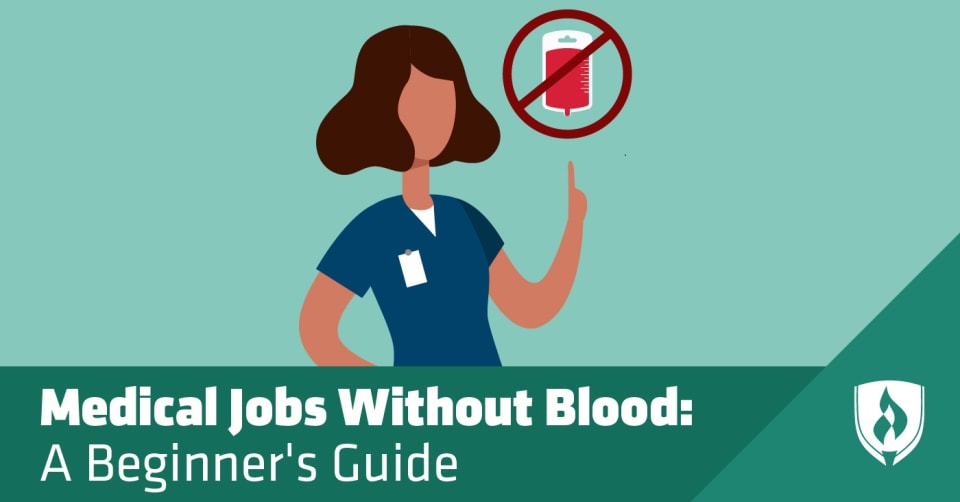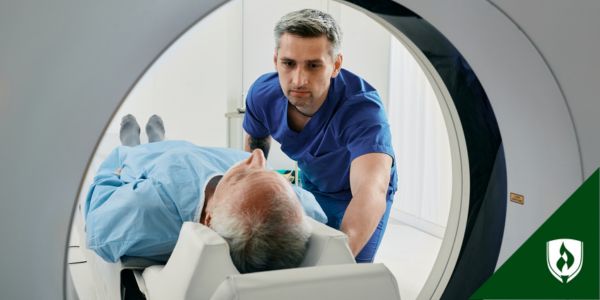
The medical field is full of potential career opportunities. While the first occupations that might spring to mind are likely going to be doctors and nurses, there are a wide variety of professionals working in medical jobs in order to keep their facilities running smoothly. Given the relative stability of the healthcare field—people are pretty much always going to get sick or injured, after all—it’s easy to understand how one of these jobs may appeal to you.
There’s just one problem: The thought of working in a job where you’re seeing blood, innards or the other generally unpleasant elements of the human body on a regular basis makes you super uncomfortable. But that doesn’t mean all hope is lost—there are a healthy number of medical jobs without blood out there for you to consider.
To help you get a better picture of what could work, we’ve compiled a list of medical jobs where you’re least likely to have contact with the red stuff in a regular day. From there we broke down our list into two primary categories: patient-oriented and technology-focused.
But before we get too far along, it’s important to note that you won’t see some jobs you might expect on this list. Some roles—like radiologic technologist, dental assistant, or medical assistant—that you wouldn’t typically associate with being “bloody” can occasionally cross paths with it, particularly during emergency situations.
Patient-focused medical jobs without blood
If you enjoy interacting with others and aren’t afraid to comfort the sick or injured, a patient-focused job in the healthcare industry could be a perfect fit for you. In these careers, you might be the first point of contact in a doctor’s office, or you could help patients re-learn skills after suffering from an injury.
The following professionals work in a variety of settings with a low risk of exposure to blood, but they all have direct contact with patients.
1. Pharmacy technician
A pharmacy technician’s main responsibility is to dispense medications. They work closely with pharmacists to fill prescriptions, mix medications and distribute medicine to patients.
Patients who visit community pharmacies like ones in grocery stores or pharmacy stores are usually relatively healthy and almost certainly not actively bleeding. Pharmacy techs can also work in pharmacies in hospitals or clinics. Those working in a hospital or pharmacy may have more communication with other hospital staff than patients. They may even be responsible for delivering medications to various nurses’ stations.
The job market for pharmacy technicians looks solid, with employment of pharmacy techs projected to grow 7 percent between 2018 and 2028.1
Getting started: Pharmacy techs should be detail-oriented and have customer service skills. While it’s possible to become a pharmacy tech with just a high school diploma, a college education or certificate program helps you stand out to potential employers. Pharmacy techs also undergo extensive on-the-job-training before being allowed to work alone.
Expect a background check for this career, due to its access to prescription drugs. Some states may also require certification.
2. Medical administrative assistant
Medical administrative assistants (sometimes referred to as medical secretaries) are often tasked with billing and interacting with patients and sometimes scheduling procedures. They take care of much of the behind-the-scenes clerical work that keeps a medical office functioning. This may include maintaining medical records, scheduling patient visits, ordering supplies and assisting patients with billing or insurance questions. While medical administrators may work in a hospital, clinic or private practice, most do not have job duties that would require them to come into contact with blood.
Getting started: A high school degree is necessary to become a medical administrator, and some employers prefer candidates to have a Medical Administrative Assistant Certificate. Either way, you’ll need to be organized, have great computer skills and be prepared for on-the-job training.
3. Physical therapist assistant
Physical therapist assistants (PTA) perform several different functions to aid patients in recovery. Patients seek physical therapy for any number of reasons including illness, injury or surgery.
As a physical therapist assistant, your responsibility is to monitor patients during therapy, help patients stretch and exercise, and assist them with any equipment they may need to improve or maintain mobility. Though patients in physical therapy may have experienced an injury or surgery that involved blood in the past, patients in physical therapy are already in the process of healing. Patients are in physical therapy to work on relieving pain, increasing mobility and gaining strength.
The field has a particular bright future, with the BLS projecting employment of PTAs to grow 27 percent between 2018 and 2028!1
Getting started: A college education is in your future if you wish to be a PTA. Typically employers are seeking candidates with an Associate’s degree, according to the BLS.1 Physical therapist assistants usually work in health practitioner offices, nursing homes or hospitals. The BLS considers compassion, physical stamina and interpersonal skills necessary to perform this job.
4. Occupational therapy assistant
While physical therapy focuses on treating patients after injury, occupational therapy helps patients with more permanent disabilities. Occupational therapy assistants (OTAs) monitor patient progress, help those with developmental disabilities improve coordination and assist patients with stretching and other therapeutic activities. Occupational therapy assistants are also commonly employed in hospitals, nursing homes and health practitioner offices. Since occupational therapy patients are not acute, occupational therapists have a very low chance of encountering blood in their work.
Getting into occupational therapy can make for a rewarding career. The job outlook for OTAs looks strong—between 2018 and 2028, employment of occupational therapy assistants is expected to grow 33 percent.1That’s much faster than the 5 percent average for all occupations.1
Getting started: An associate’s degree is usually required to be an occupational therapy assistant, according to the BLS.1 Additionally, most are licensed through the National Board for Certification in Occupational Therapy—but licensing requirements vary by state. Physical strength and compassion are considered by the BLS to be important qualities for those seeking this career.
Technology-focused medical jobs without blood
If working with patients is more your idea of a nightmare than a dream job, don’t worry. The healthcare field offers many jobs that are more behind-the-scenes. If you love working with technology, there are even more choices available.
Healthcare is a booming and complex field. As systems fight to become safer, more reliable and more efficient, the demand for technology professionals in healthcare is rising.
1. Medical coder
Electronic health records have paved the way for a handful of healthcare technology careers—and medical coders are a prominent example. Medical coders analyze and manage patient data, navigate electronic health records systems and code notes from patient appointments.
While medical coders can work in hospitals, outpatient clinics, and even potentially from home once well-established, they’re always in an office setting—far away from any bleeding patients.3 Medical coders can advance by earning additional professional certifications.
Employment of medical coders appears strong in the near future. According to the BLS, employment of medical coders is projected to grow 11 percent between 2018 and 2028.1
Getting started: To get started in a medical coding role you’ll likely need to pursue additional education beyond high school—like a Medical Billing and Coding Certificate. You might also consider earning a medical coding professional certification.
2. Health information technician
Health information technicians organize and maintain databases, review patient records, perform data analysis and track patient outcomes.
Most health information technicians work in office settings in hospitals or clinics. They can also work in chiropractic offices, dental offices, nursing homes, billing departments, or insurance companies. Though they work with patient records, their role isn’t patient-facing, so there’s very little chance you’d encounter blood in this healthcare role.
Since medical coders and health information technician work in very closely related roles which sometimes overlap, the BLS groups these roles together for their occupational data. This includes a projected job growth of 11 percent by 2028.1
Getting started: Many health information technicians have an Associate’s degree. In addition, most employers require these professionals to be a Registered Health Information Technician (RHIT), as certified by passing the RHIT exam.
3. Health information manager
If you’re interested in what health information technicians do, but want more of a challenge, a career as a health information manager is worth considering. In addition to database maintenance, health information managers have to be knowledgeable about coding and software, as well as constantly fluctuating industry rules and regulations. They’re typically employed by the same organizations that employ health information technicians—hospitals, clinics, insurance providers and government agencies.
While the BLS does not collect data for this specific form of healthcare management role, employment of health and medical service managers overall is projected to grow 18 percent from 2018 through 2028.1
Getting started: Most health information managers have at least a Bachelor’s degree and sometimes a master’s degree. Many employers also require candidates to obtain Registered Health Information Administrator (RHIA) certification.
And there are still more …
These are only a handful of career paths for those seeking medical careers without blood. Whether you hope to be directly involved in patient care, or directly involved with technology (or both), there is definitely a place for you in the field of health sciences. Check out our article, "8 Different Medical Careers for Weak Stomachs".
If you’re ready to get started, head over to our to Health Sciences programs page to find the right education option for launching your healthcare career.
Still weighing your options? Our article, “Exploring 12 Healthcare Jobs You Can Launch in 2 Years or Less,” can help expand your search—though some may be a little less pleasant on the blood front!
Related Articles:
1Bureau of Labor Statistics, U.S. Department of Labor, Occupational Outlook Handbook, [accessed June, 2020] www.bls.gov/ooh/. Information represents national, averaged data for the occupations listed and includes workers at all levels of education and experience. Employment conditions in your area may vary.
2Bureau of Labor Statistics, U.S. Department of Labor, Occupational Employment Statistics, [accessed June, 2020] www.bls.gov/oes/. Information represents national, averaged data for the occupations listed and includes workers at all levels of education and experience. Employment conditions in your area may vary.
3Most coding positions are not considered "entry level"; a combination of education and work experience is typically required to attain a coding position. Similarly, coders, especially those who are new to the field, should not expect to find a position where they can work from home. Most coding positions require onsite work.




